Microscopic Study of Shale Anisotropy with SEM In Situ Compression and Three-Point Bending Experiments
Abstract
:1. Introduction
2. Experimental Methods
2.1. Sample Preparation
2.2. Experimental Procedures
3. Experimental Results
3.1. Microscopic Deformation Characteristics during Compressive Loading
3.2. Microscopic Cracking Process and Crack Path in Three-Point Bending Tests
3.3. Anisotropy of Microscopic Mechanical Properties
4. Conclusions
- (1)
- During the loading process of the compression experiments, the microscopic deformations of the shale specimens were mainly concentrated in the clay mineral accumulation area and at the microcracks. Most of the microcracks were aligned with the bedding plane direction, and the compression loading led to the expansion or compression of the microcracks for different bedding angle cases. Meanwhile, due to the disordered arrangement of clay minerals, the shear strain was generated and resulted in the simultaneous concentration of positive and negative strains in the clay minerals.
- (2)
- The microscopic anisotropy revealed by the cracking processes and crack paths in the three-point bending tests are strongly related to the crack-bedding orientation relationship. The type-ST and type-A cases both showed clear crack initiation and formed a relatively smooth crack surface, while the type-D cases showed the highest peak loads, more abrupt breaks and formed visibly tortuous cracks, which was consistent with their high fracture toughness and elastic-bending modulus parameters. Additionally, the type-A cases developed the longest cracks among the three testing groups.
- (3)
- For the investigated shale specimens in compression tests, both the peak load and the compressive strength were lower when the bedding angle was 30°, and the elastic moduli were lower when the bedding angle was 60°. The corresponding shear strain results calculated by the DIC method showed that the shear deformations were larger when the bedding angles were 30° and 60°.
- (4)
- The parameters of the peak load, tensile strength, fracture toughness and elastic-bending modulus of shale specimens also showed obvious anisotropic characteristics in the three-point bending test. For type-ST crack cases, the above parameters were lower than the type-D and type-A cases.
Author Contributions
Funding
Data Availability Statement
Conflicts of Interest
References
- Cao, H.; Gao, Q.; Ye, G.; Zhu, H.; Sun, P. Experimental investigation on anisotropic characteristics of marine shale in Northwestern Hunan, China. J. Nat. Gas Sci. Eng. 2020, 81, 103421. [Google Scholar] [CrossRef]
- Heng, S.; Li, X.; Liu, X.; Chen, Y. Experimental study on the mechanical properties of bedding planes in shale. J. Nat. Gas Sci. Eng. 2020, 76, 103161. [Google Scholar] [CrossRef]
- Niandou, H.; Shao, J.F.; Henry, J.P.; Fourmaintraux, D. Laboratory investigation of the mechanical behaviour of Tournemire shale. Int. J. Rock Mech. Min. Sci. 1997, 34, 3–16. [Google Scholar] [CrossRef]
- Kuila, U.; Dewhurst, D.; Siggins, A.; Raven, M. Stress anisotropy and velocity anisotropy in low porosity shale. Tectonophysics 2011, 503, 34–44. [Google Scholar] [CrossRef]
- Cho, J.W.; Kim, H.; Jeon, S.; Min, K.B. Deformation and strength anisotropy of Asan gneiss, Boryeong shale, and Yeoncheon schist. Int. J. Rock Mech. Min. Sci. 2012, 50, 158–169. [Google Scholar] [CrossRef]
- Lo, T.; Coyner, K.B.; Toksöz, M.N. Experimental determination of elastic anisotropy of Berea sandstone, Chicopee shale, and Chelmsford granite. Geophysics 1986, 51, 164–171. [Google Scholar] [CrossRef]
- Luo, Y.; Xie, H.P.; Ren, L.; Zhang, R.; Li, C.B.; Gao, C. Linear Elastic Fracture Mechanics Characterization of an Anisotropic Shale. Sci. Rep. 2018, 8, 8505. [Google Scholar] [CrossRef] [Green Version]
- Zuo, J.; Lu, J.; Ghandriz, R.; Wang, J.; Li, Y.; Zhang, X.; Li, J.; Li, H. Mesoscale fracture behavior of Longmaxi outcrop shale with different bedding angles: Experimental and numerical investigations. J. Rock Mech. Geotech. Eng. 2020, 12, 89–101. [Google Scholar] [CrossRef]
- Chandler, M.R.; Meredith, P.G.; Brantut, N.; Crawford, B.R. Fracture toughness anisotropy in shale. J. Geophys. Res. Solid Earth 2016, 121, 1706–1729. [Google Scholar] [CrossRef] [Green Version]
- Chong, Z.; Li, X.; Hou, P.; Wu, Y.; Zhang, J.; Chen, T.; Liang, S. Numerical Investigation of Bedding Plane Parameters of Transversely Isotropic Shale. Rock Mech. Rock Eng. 2017, 50, 1183–1204. [Google Scholar] [CrossRef]
- Yoon, J. Application of experimental design and optimization to PFC model calibration in uniaxial compression simulation. Int. J. Rock Mech. Min. Sci. 2007, 44, 871–889. [Google Scholar] [CrossRef]
- Lu, Y.; Li, W.; Wang, L.; Meng, X.; Wang, B.; Zhang, K.; Zhang, X. In-situ microscale visualization experiments on microcracking and microdeformation behaviour around a pre-crack tip in a three-point bending sandstone. Int. J. Rock Mech. Min. Sci. 2019, 114, 175–185. [Google Scholar] [CrossRef]
- Wang, L.; Bornert, M.; Héripré, E.; Chanchole, S.; Pouya, A.; Halphen, B. Microscale insight into the influence of humidity on the mechanical behavior of mudstones. J. Geophys. Res. Solid Earth 2015, 120, 3173–3186. [Google Scholar] [CrossRef]
- Wang, L.L.; Zhang, G.Q.; Hallais, S.; Tanguy, A.; Yang, D.S. Swelling of Shales: A Multiscale Experimental Investigation. Energy Fuels 2017, 31, 10442–10451. [Google Scholar] [CrossRef]
- Zhou, J.; Zeng, Y.; Guo, Y.; Chang, X.; Liu, L.; Wang, L.; Hou, Z.; Yang, C. Effect of natural filling fracture on the cracking process of shale Brazilian disc containing a central straight notched flaw. J. Pet. Sci. Eng. 2020, 196, 107993. [Google Scholar] [CrossRef]
- Li, Y.; Wang, S.; Zheng, L.; Zhao, S.; Zuo, J. Evaluation of the fracture mechanisms and criteria of bedding shale based on three-point bending experiment. Eng. Fract. Mech. 2021, 255, 107913. [Google Scholar] [CrossRef]
- Gao, Q.; Tao, J.; Hu, J.; Yu, X. Laboratory study on the mechanical behaviors of an anisotropic shale rock. J. Rock Mech. Geotech. Eng. 2015, 7, 213–219. [Google Scholar] [CrossRef] [Green Version]
- Bennett, K.C.; Berla, L.A.; Nix, W.D.; Borja, R.I. Instrumented nanoindentation and 3D mechanistic modeling of a shale at multiple scales. Acta Geotech. 2015, 10, 1–14. [Google Scholar] [CrossRef]
- Eliyahu, M.; Emmanuel, S.; Day-Stirrat, R.J.; Macaulay, C.I. Mechanical properties of organic matter in shales mapped at the nanometer scale. Mar. Pet. Geol. 2015, 59, 294–304. [Google Scholar] [CrossRef]
- Wu, Y.; Li, Y.; Luo, S.; Lu, M.; Zhou, N.; Wang, D.; Zhang, G. Multiscale elastic anisotropy of a shale characterized by cross-scale big data nanoindentation. Int. J. Rock Mech. Min. Sci. 2020, 134, 104458. [Google Scholar] [CrossRef]
- Schmidt, R.A. Fracture Mechanics Of Oil Shale-Unconfined Fracture Toughness, Stress Corrosion Cracking, And Tension Test Results. ARMA-77-0082. In Proceedings of the 18th U.S. Symposium on Rock Mechanics (USRMS), Golden, CO, USA, 22–24 June 1977. [Google Scholar]
- Chong, K.P.; Kuruppu, M.D.; Kuszmaul, J.S. Fracture toughness determination of layered materials. Eng. Fract. Mech. 1987, 28, 43–54. [Google Scholar] [CrossRef]
- Swan, G.; Cook, J.; Bruce, S.; Meehan, R. Strain rate effects in Kimmeridge bay shale. Int. J. Rock Mech. Min. Sci. Geomech. Abstr. 1989, 26, 135–149. [Google Scholar] [CrossRef]
- Maqsood, Z.; Koseki, J.; Ahsan, K.; Shaikh, M.; Kyokawa, H. Experimental study on hardening characteristics and loading rate dependent mechanical behaviour of gypsum mixed sand. Constr. Build. Mater. 2020, 262, 119992. [Google Scholar] [CrossRef]
- Maqsood, Z.; Koseki, J.; Kyokawa, H. Effects of loading rate on strength and deformation characteristics of gypsum mixed sand. E3S Web Conf. 2019, 92, 05008. [Google Scholar] [CrossRef]
- Maqsood, Z.; Koseki, J.; Miyashita, Y.; Xie, J.; Kyokawa, H. Experimental study on the mechanical behaviour of bounded geomaterials under creep and cyclic loading considering effects of instantaneous strain rates. Eng. Geol. 2020, 276, 105774. [Google Scholar] [CrossRef]
- Loucks, R.G.; Reed, R.M.; Ruppel, S.C.; Hammes, U. Spectrum of pore types and networks in mudrocks and a descriptive classification for matrix-related mudrock pores. AAPG Bull. 2012, 96, 1071–1098. [Google Scholar] [CrossRef] [Green Version]
- Tada, H.; Paris, P.C.; Irwin, G.R. The Stress Analysis of Cracks Handbook, 3rd ed.; Tada, H., Ed.; ASME Press: Hoboken, NJ, USA, 2000. [Google Scholar]
- Cesar, P.F.; Miranda, W.G.; Braga, R.R. Influence of shade and storage time on the flexural strength, flexural modulus, and hardness of composites used for indirect restorations. J. Prosthet. Dent. 2001, 86, 289–296. [Google Scholar] [CrossRef] [PubMed]




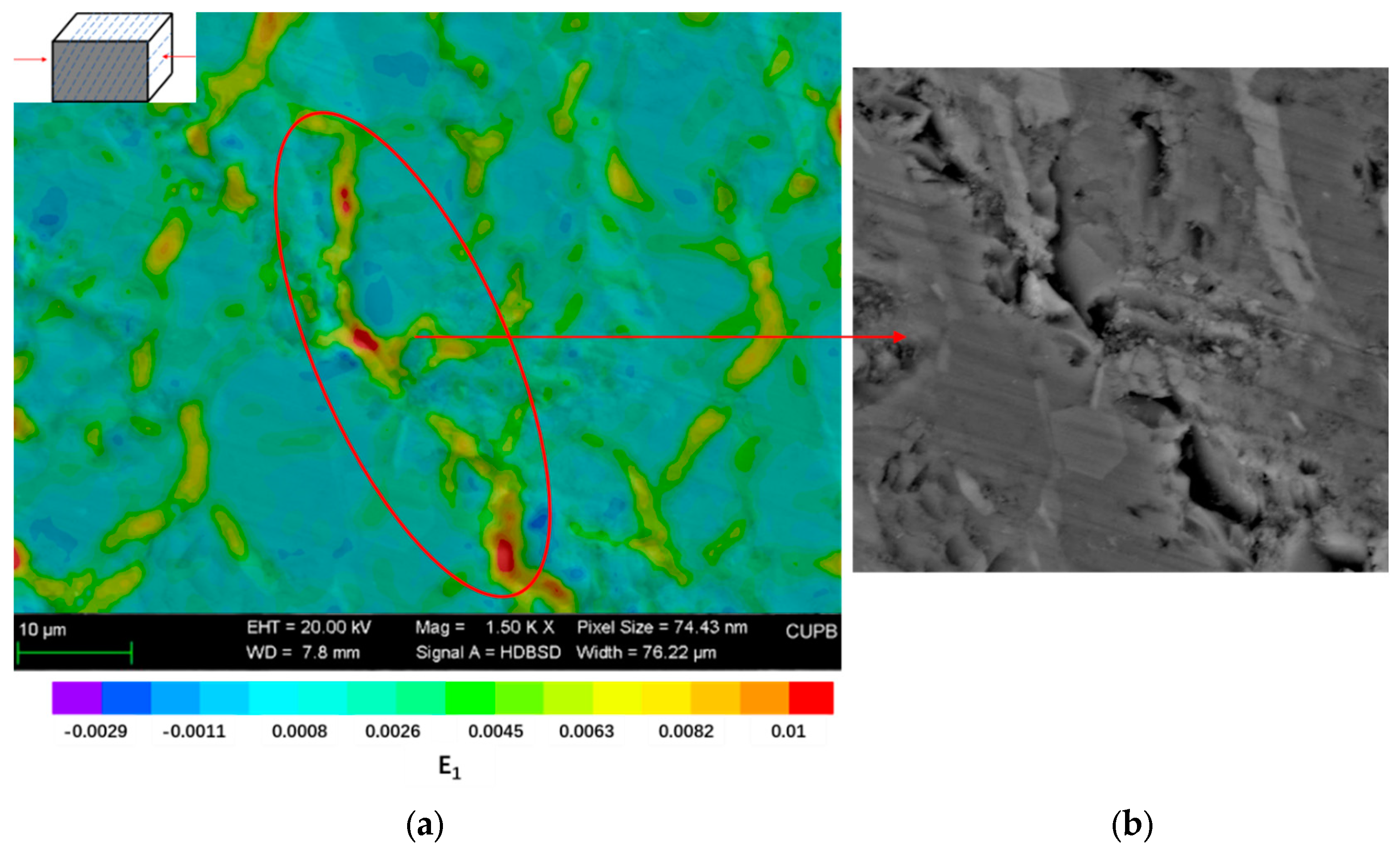
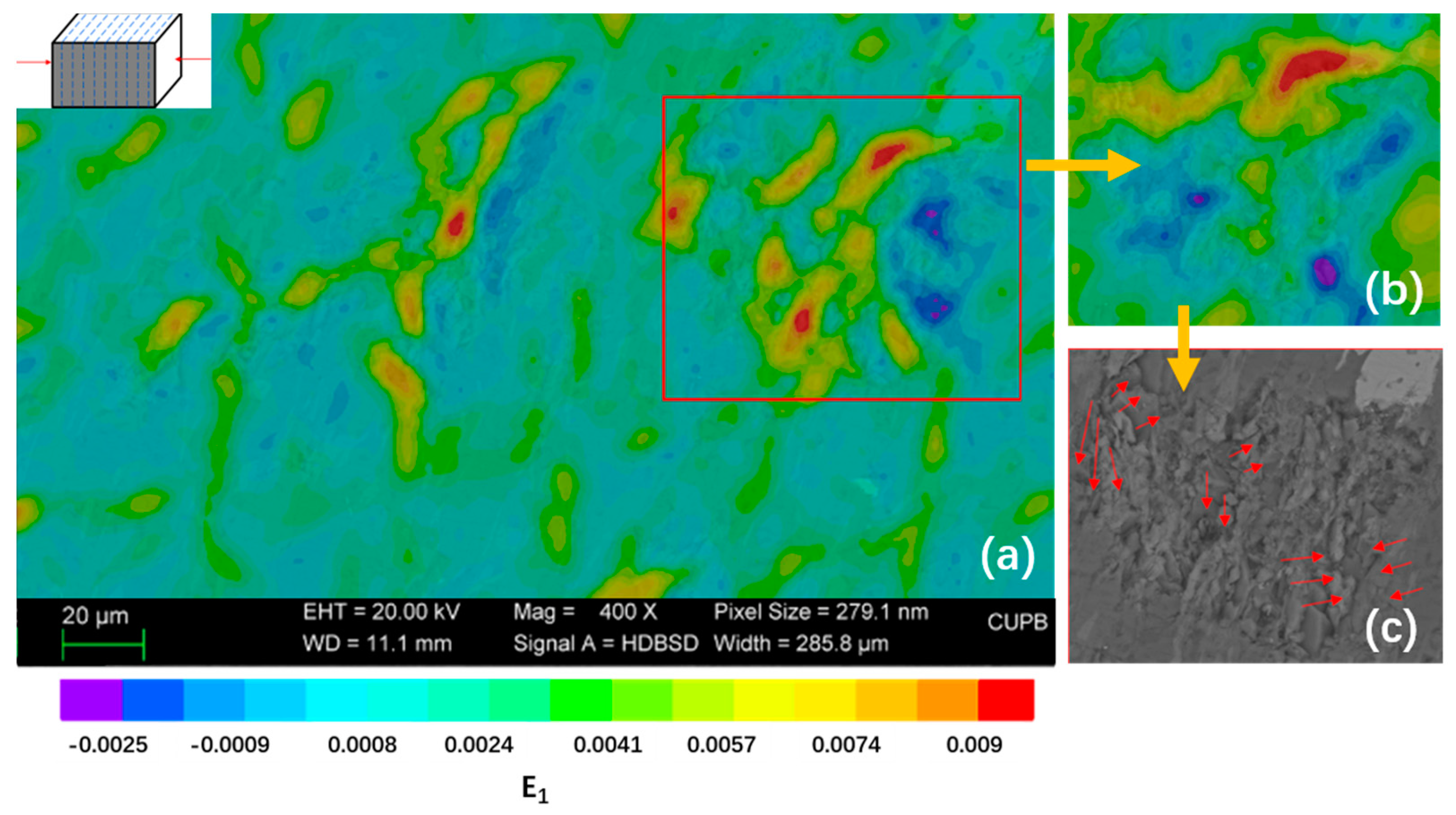
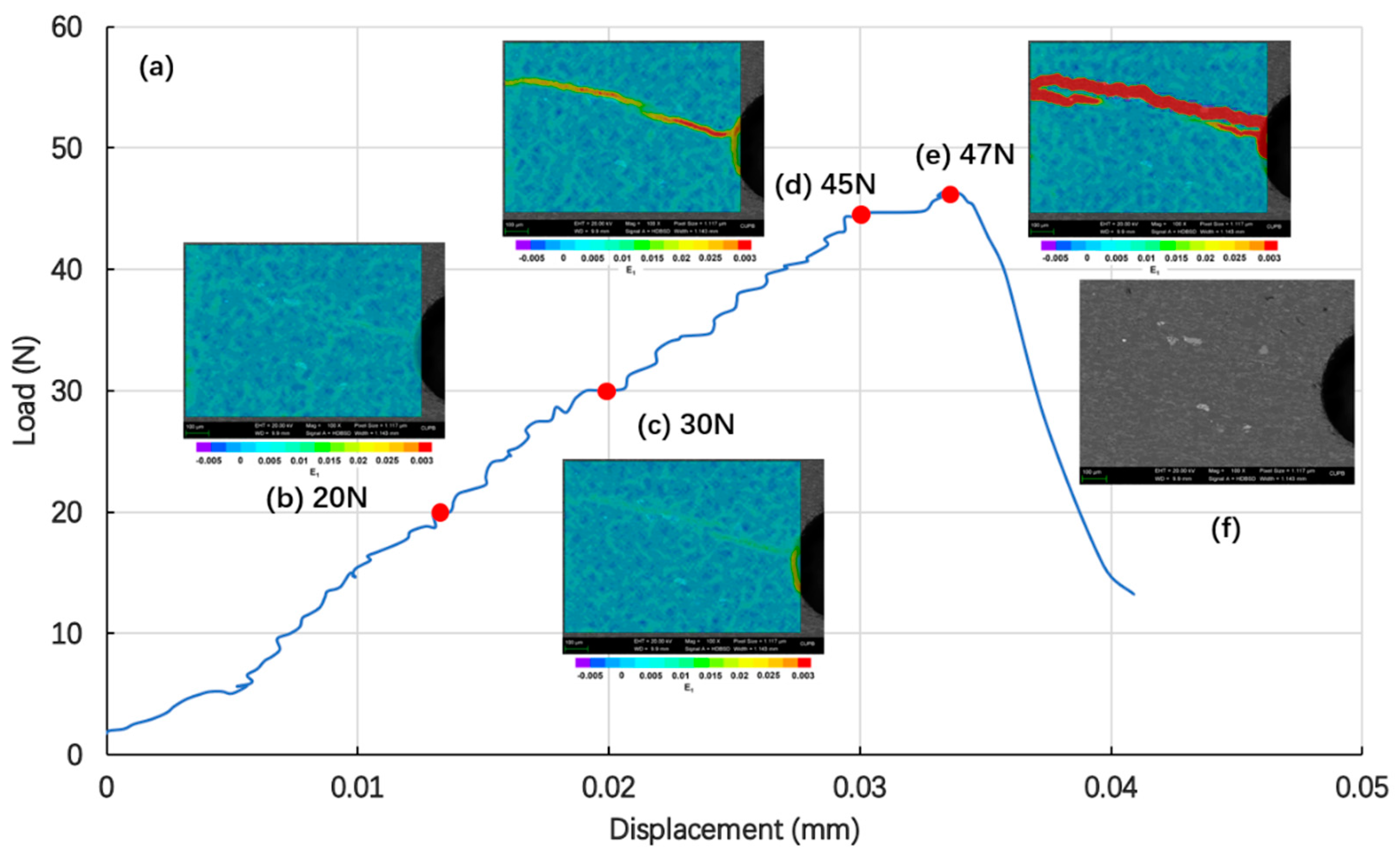

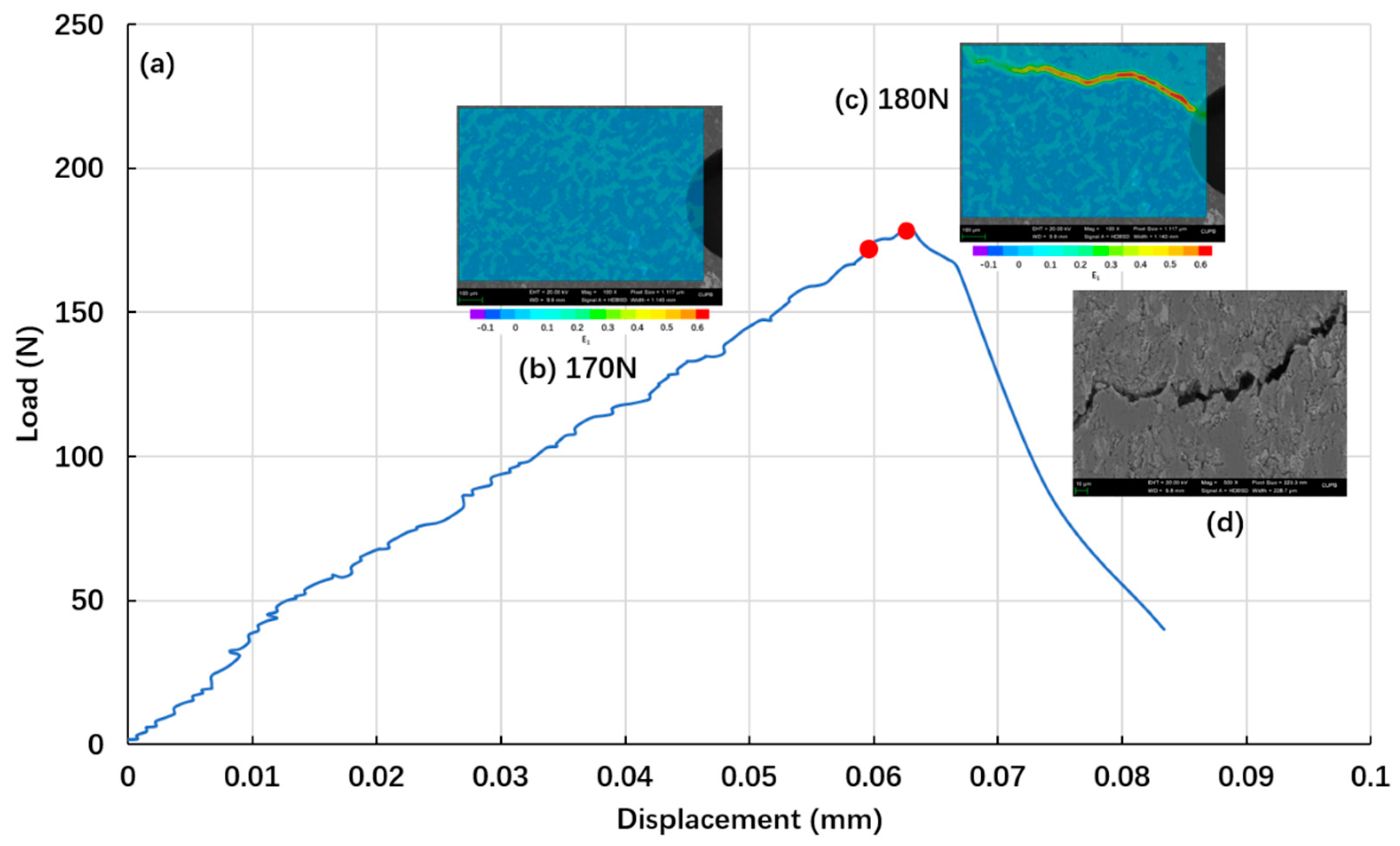
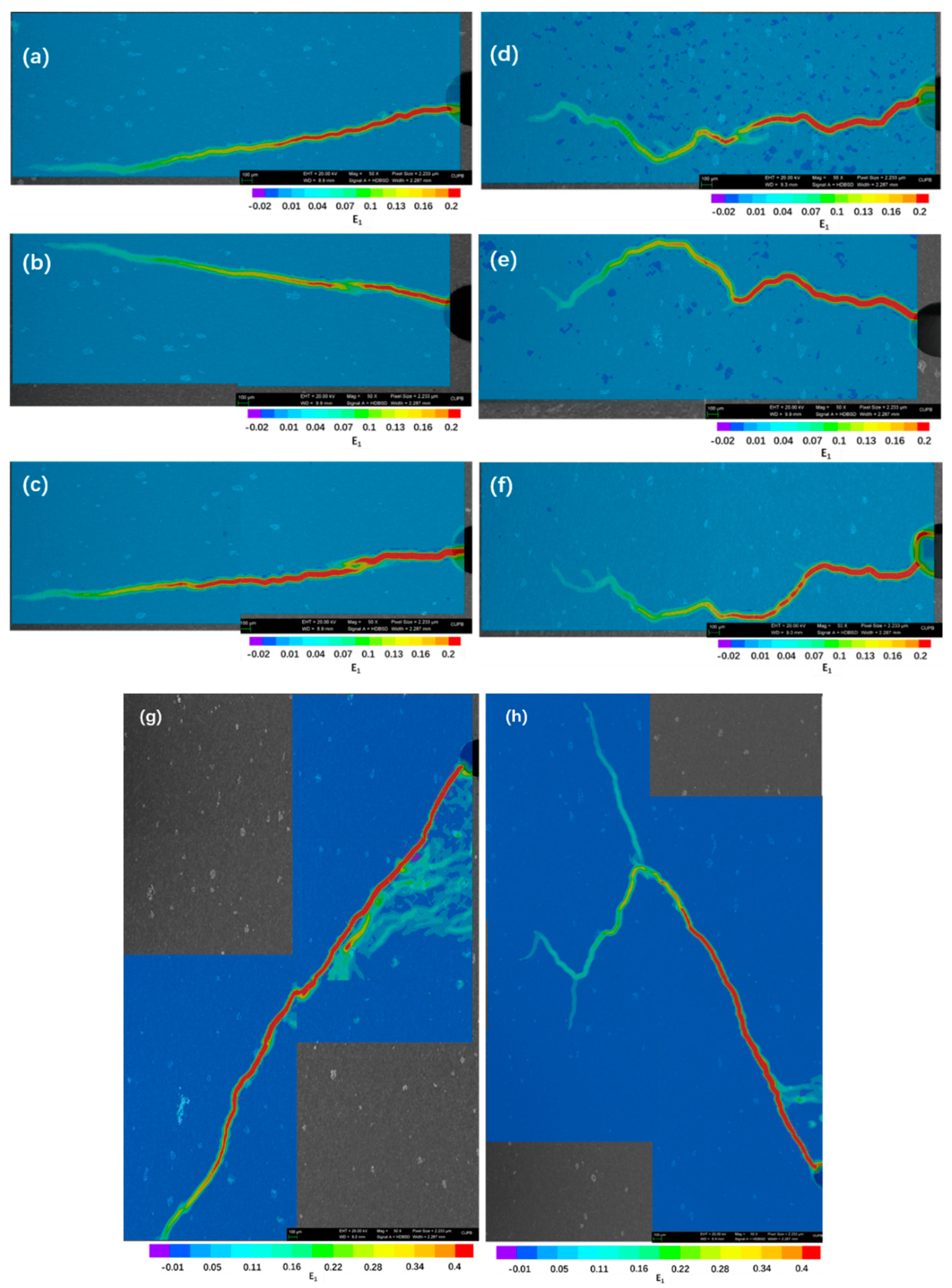

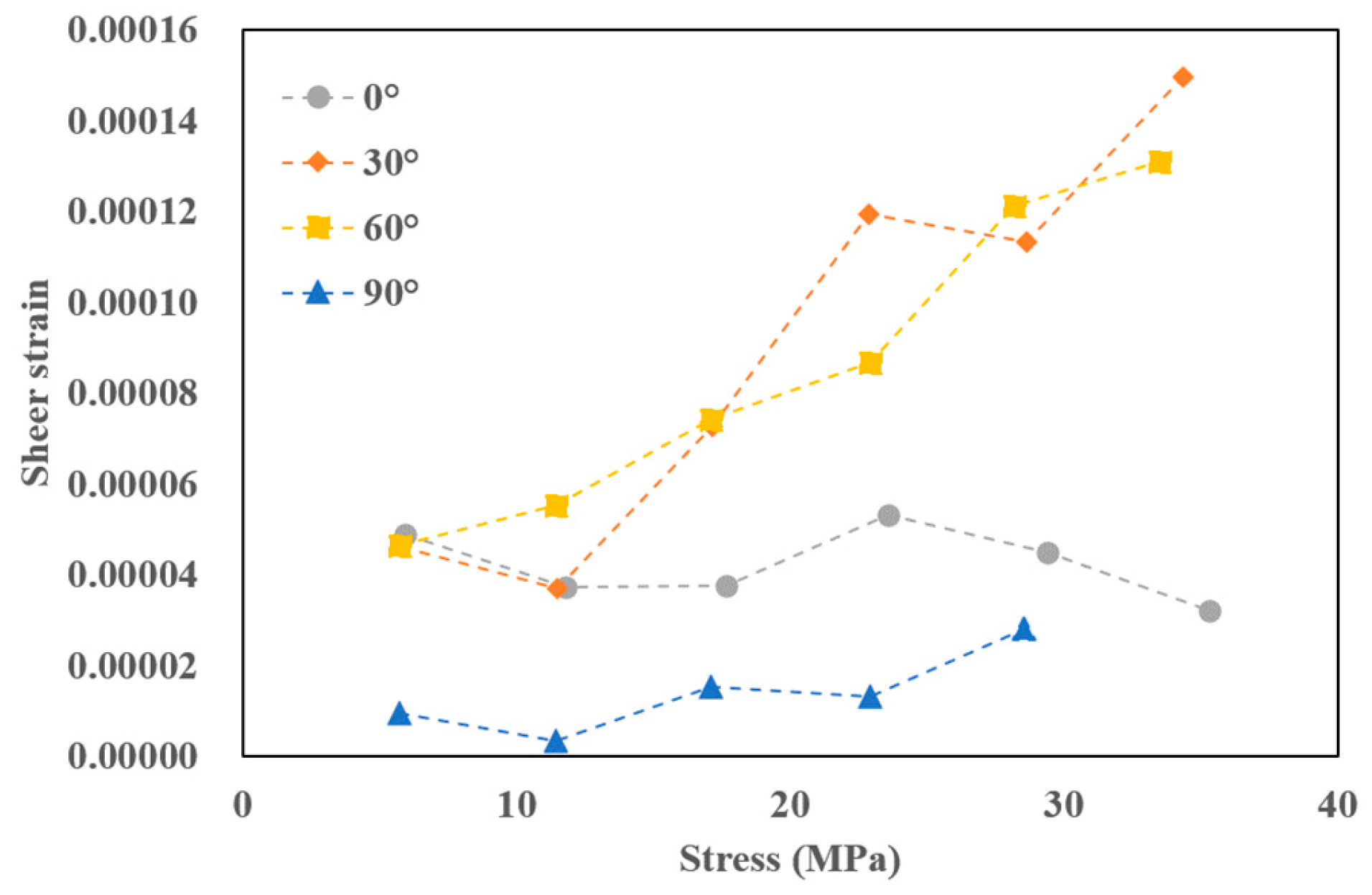
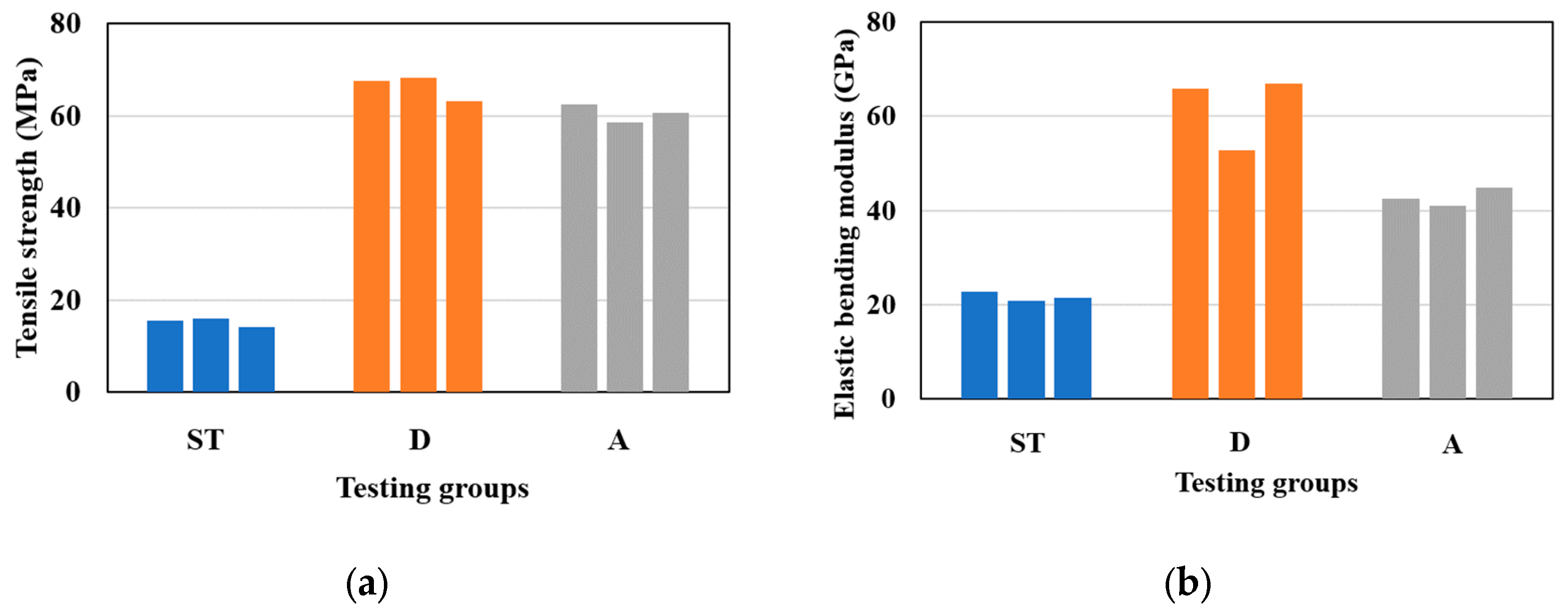
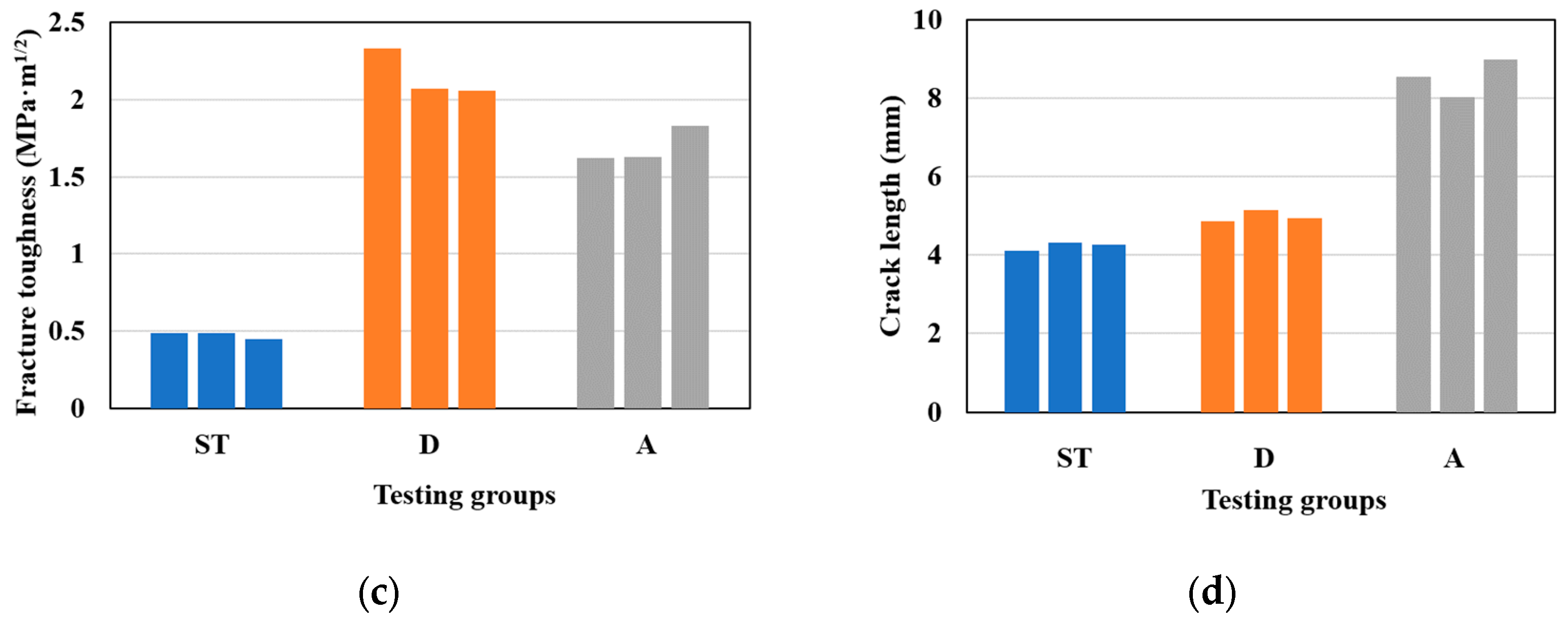
| Mineral Types | Quartz | Dolomite | Calcite | Potassium Feldspar | Plagioclase | Pyrite | Clay |
|---|---|---|---|---|---|---|---|
| Mass percentage (%) | 37.5 | 21.3 | 14.4 | 0.4 | 5.0 | 2.3 | 18.9 |
| Group | Specimen | Length (mm) | Width (mm) | Thickness (mm) | Peak Load (N) | Average Peak Load (N) | Standard Deviation of the Peak Load (N) |
|---|---|---|---|---|---|---|---|
| 0° | 0°-1 | 8.10 | 6.10 | 5.90 | 2199.67 | 2234.43 | 28.37 |
| 0°-2 | 8.10 | 6.05 | 5.84 | 2234.48 | |||
| 0°-3 | 8.00 | 6.08 | 5.90 | 2269.15 | |||
| 30° | 30°-1 | 8.04 | 5.90 | 5.92 | 1200.51 | 1322.79 | 107.70 |
| 30°-2 | 8.10 | 5.90 | 5.90 | 1462.58 | |||
| 30°-3 | 8.06 | 5.94 | 5.92 | 1305.29 | |||
| 60° | 60°-1 | 8.10 | 5.90 | 5.92 | 2221.18 | 2048.30 | 128.45 |
| 60°-2 | 8.08 | 5.94 | 5.94 | 1913.57 | |||
| 60°-3 | 8.06 | 5.90 | 5.94 | 2010.15 | |||
| 90° | 90°-1 | 7.90 | 5.90 | 5.90 | 2399.83 | 2199.76 | 311.00 |
| 90°-2 | 7.95 | 6.00 | 5.88 | 1760.52 | |||
| 90°-3 | 8.08 | 5.90 | 5.84 | 2438.93 | |||
| Arrester (A) | A-1 | 50.04 | 5.06 | 8.02 | 210.4 | 202.23 | 6.11 |
| A-2 | 50.02 | 5.00 | 8.08 | 200.6 | |||
| A-3 | 50.10 | 5.04 | 8.06 | 195.7 | |||
| Divider (D) | D-1 | 50.04 | 5.06 | 8.02 | 165.7 | 170.57 | 4.69 |
| D-2 | 50.02 | 5.00 | 8.08 | 169.1 | |||
| D-3 | 50.10 | 5.04 | 8.06 | 176.9 | |||
| Short Transverse (ST) | ST-1 | 50.06 | 5.04 | 8.06 | 48.5 | 47.53 | 0.92 |
| ST-2 | 50.08 | 5.04 | 8.06 | 46.3 | |||
| ST-3 | 50.12 | 5.02 | 8.04 | 47.8 |
Disclaimer/Publisher’s Note: The statements, opinions and data contained in all publications are solely those of the individual author(s) and contributor(s) and not of MDPI and/or the editor(s). MDPI and/or the editor(s) disclaim responsibility for any injury to people or property resulting from any ideas, methods, instructions or products referred to in the content. |
© 2023 by the authors. Licensee MDPI, Basel, Switzerland. This article is an open access article distributed under the terms and conditions of the Creative Commons Attribution (CC BY) license (https://creativecommons.org/licenses/by/4.0/).
Share and Cite
Sui, W.; Wang, Y.; Li, J. Microscopic Study of Shale Anisotropy with SEM In Situ Compression and Three-Point Bending Experiments. Energies 2023, 16, 2440. https://doi.org/10.3390/en16052440
Sui W, Wang Y, Li J. Microscopic Study of Shale Anisotropy with SEM In Situ Compression and Three-Point Bending Experiments. Energies. 2023; 16(5):2440. https://doi.org/10.3390/en16052440
Chicago/Turabian StyleSui, Weibo, Yulong Wang, and Junwei Li. 2023. "Microscopic Study of Shale Anisotropy with SEM In Situ Compression and Three-Point Bending Experiments" Energies 16, no. 5: 2440. https://doi.org/10.3390/en16052440




